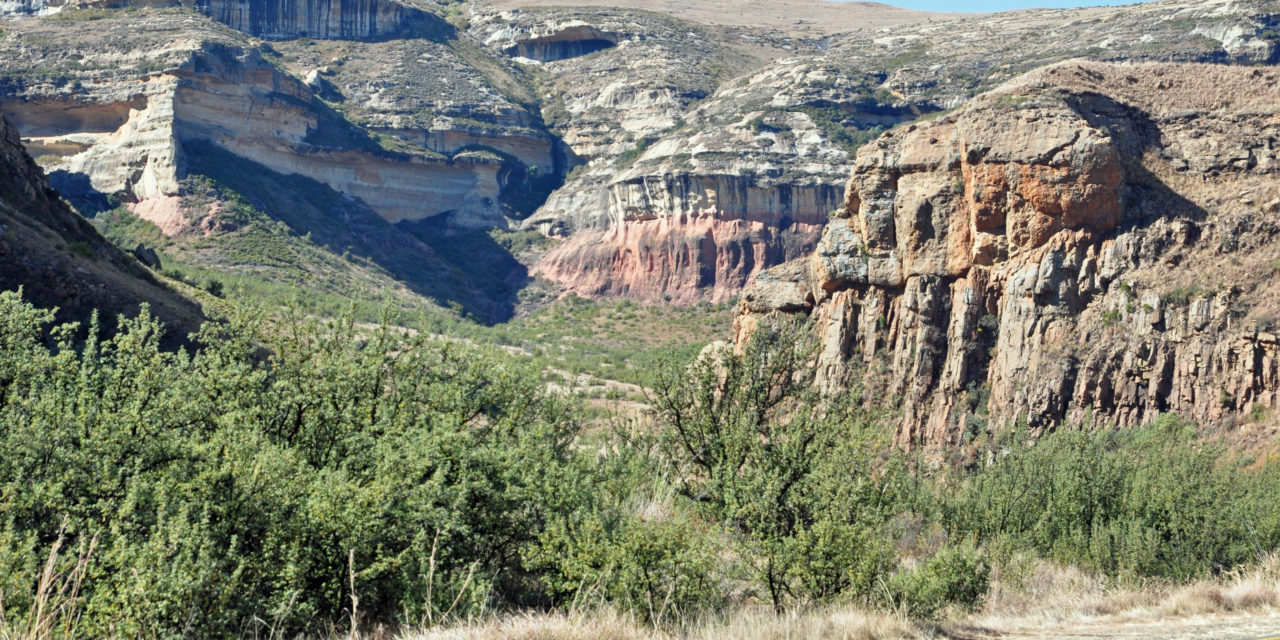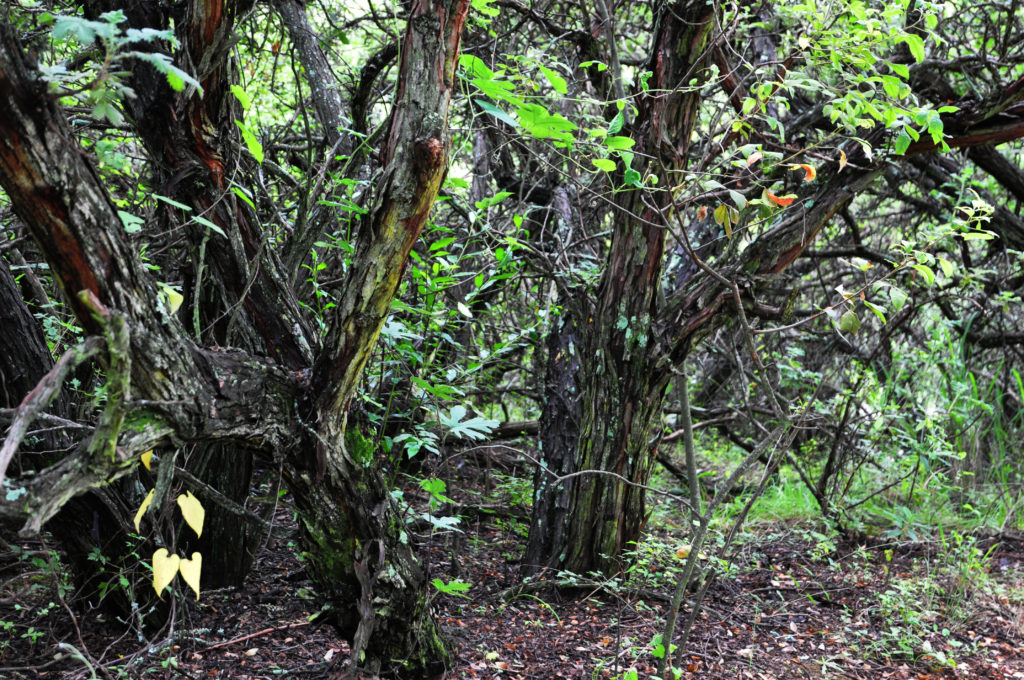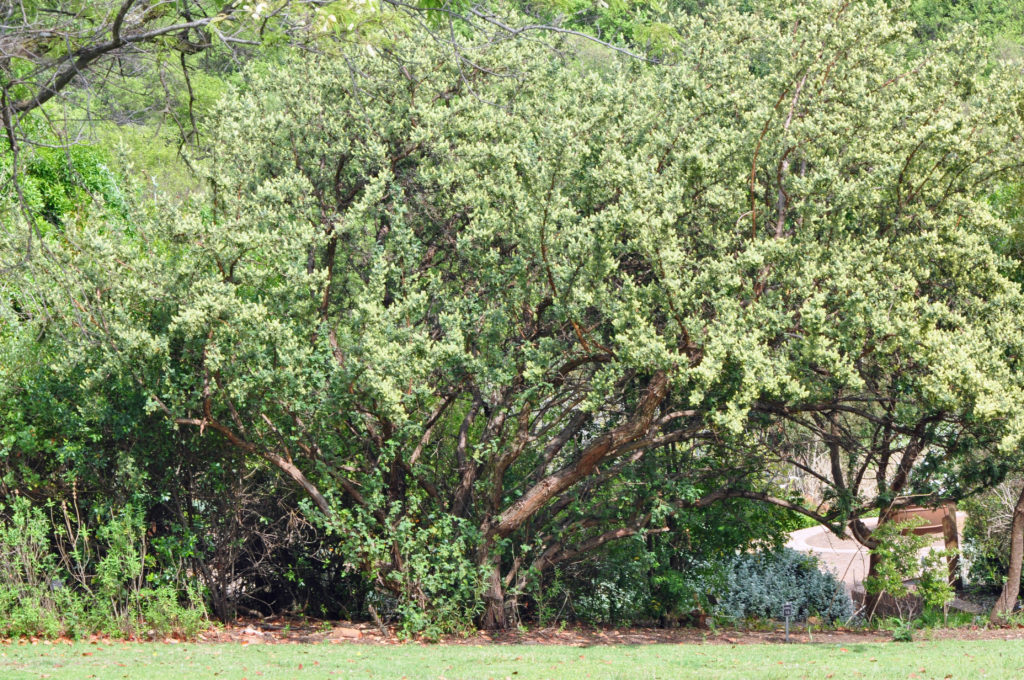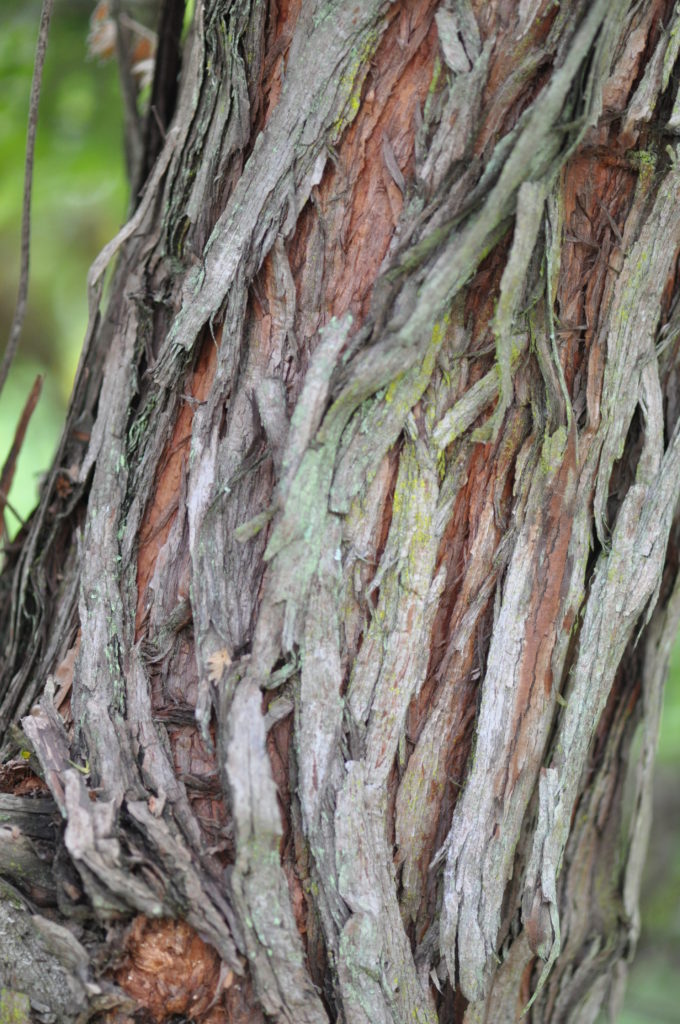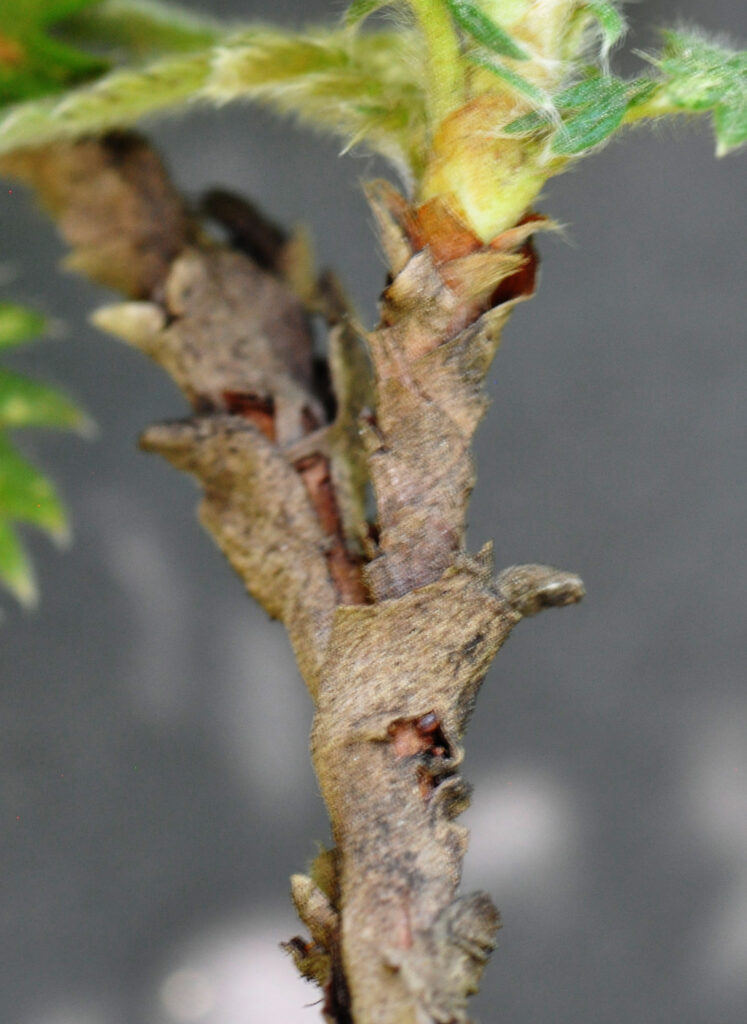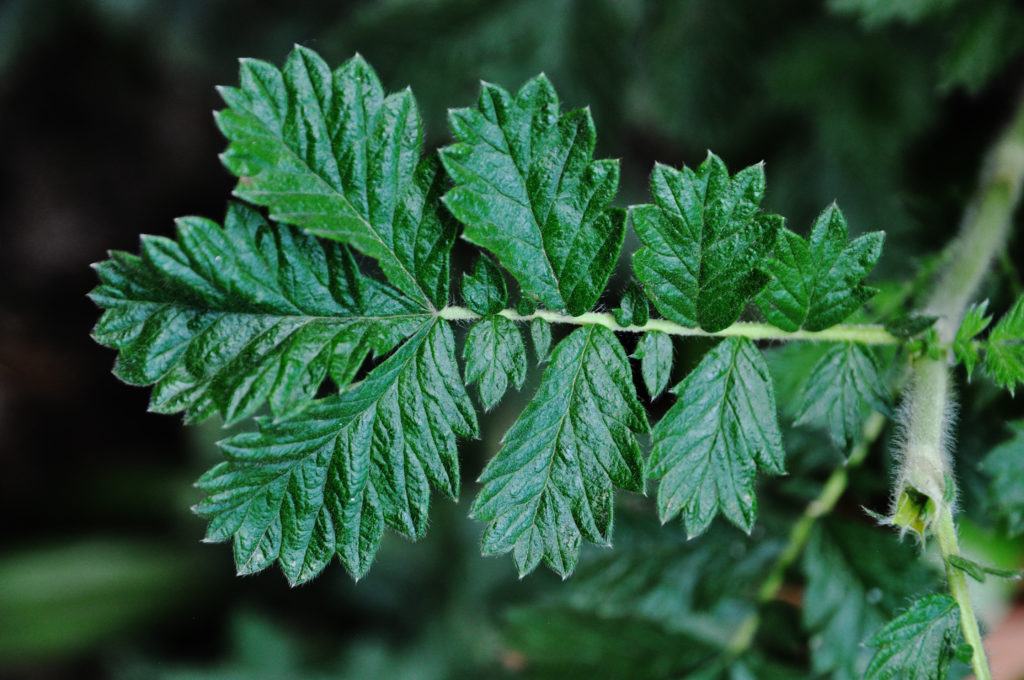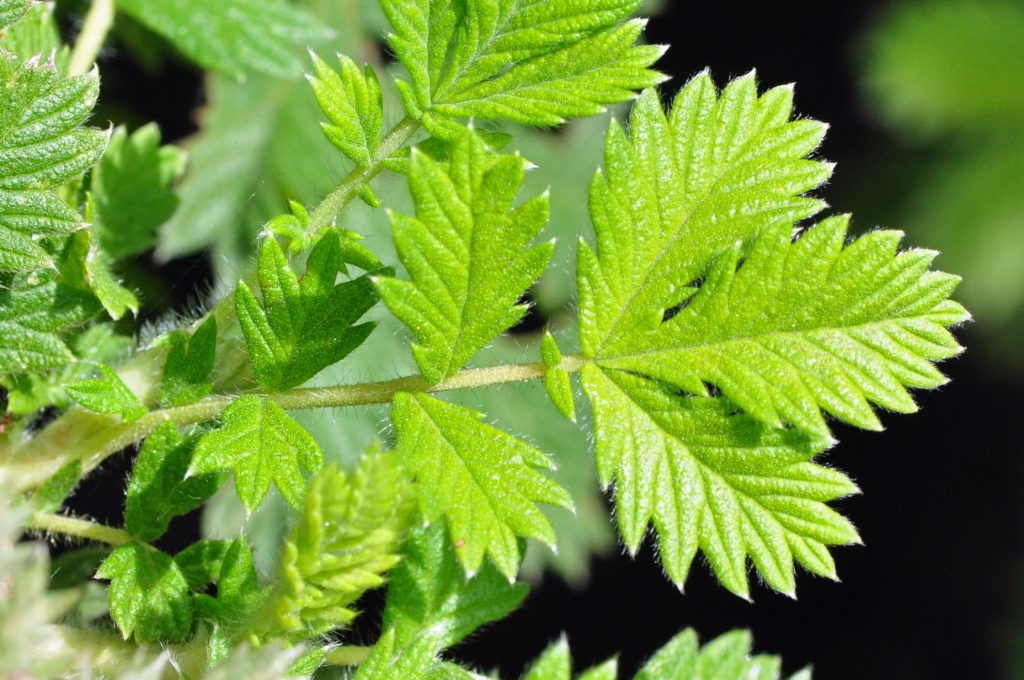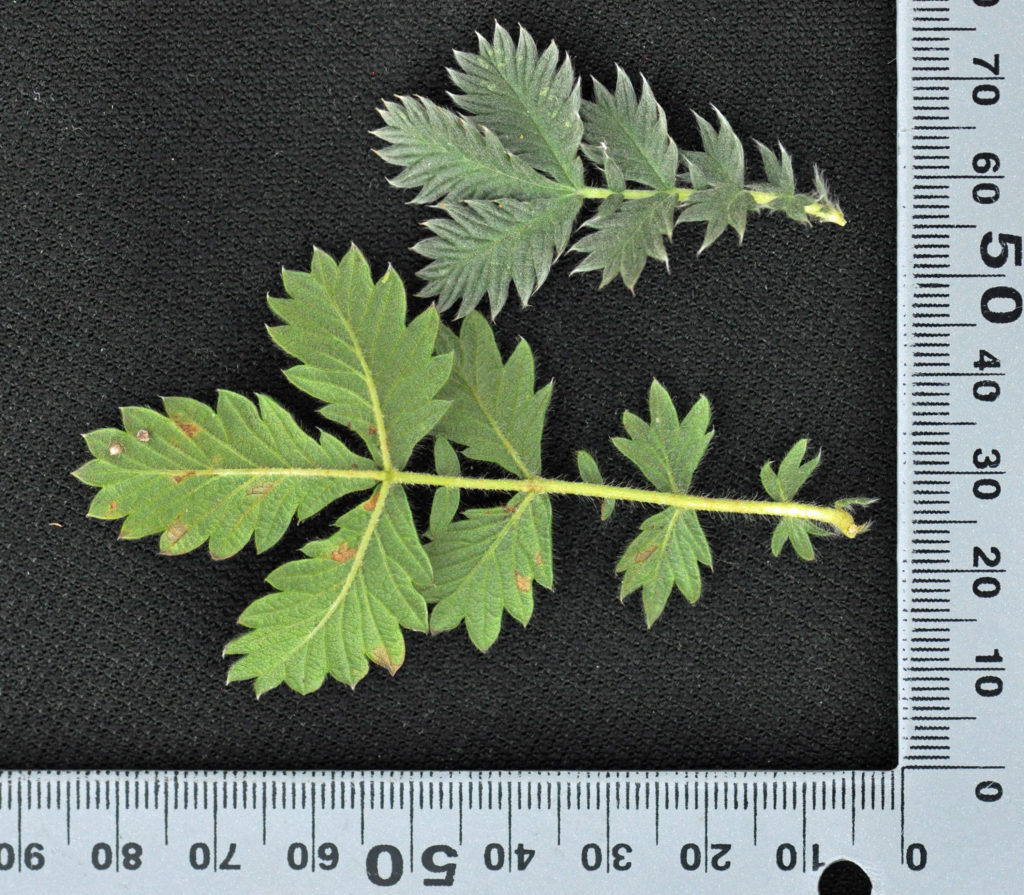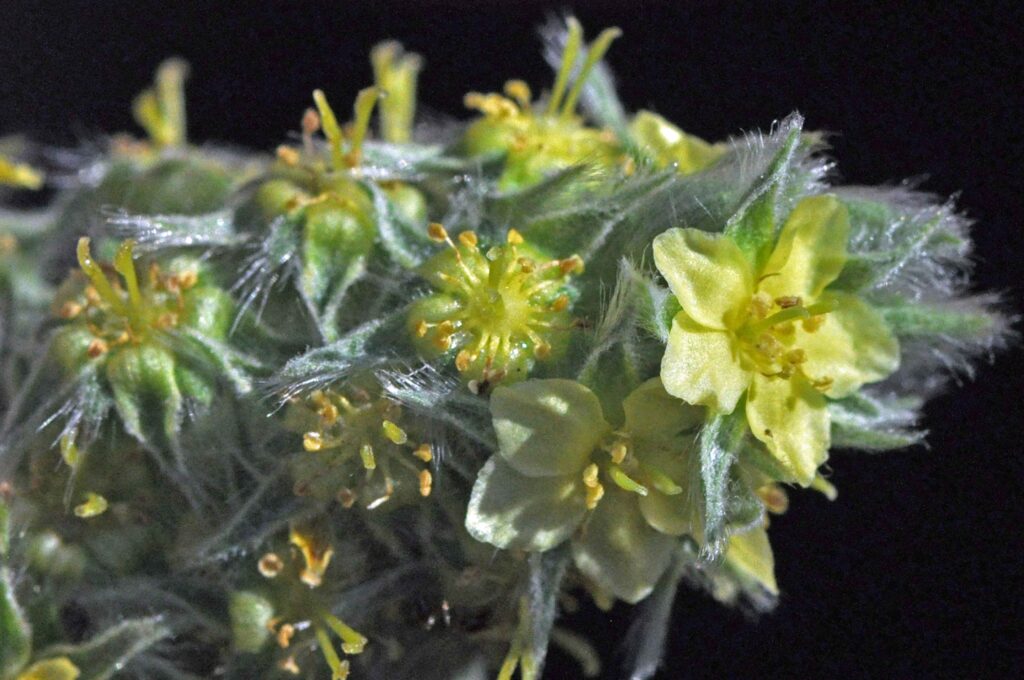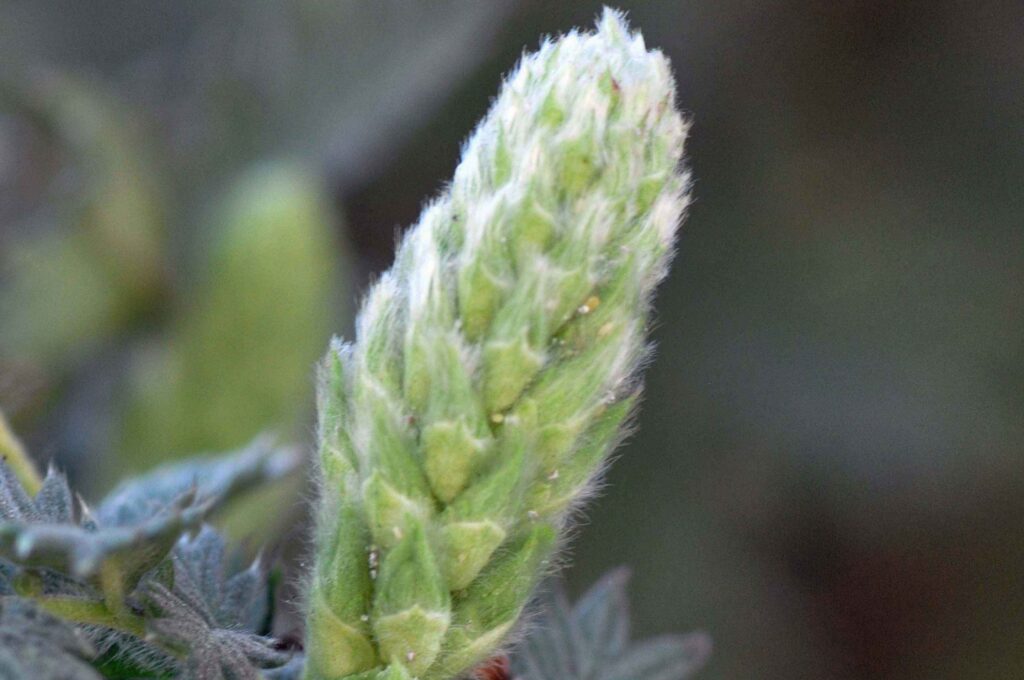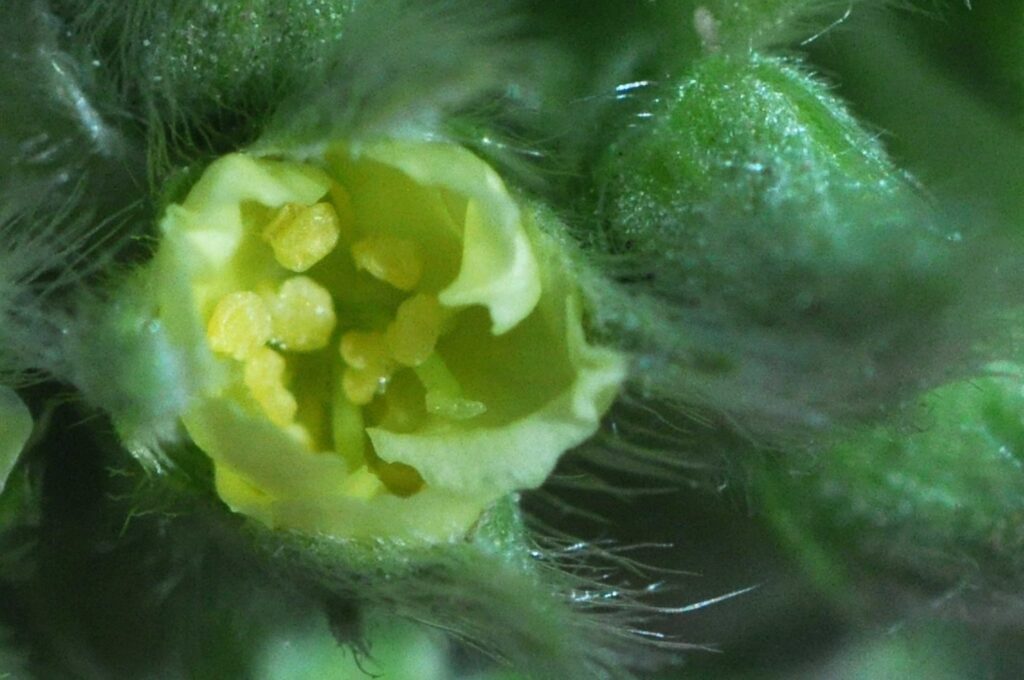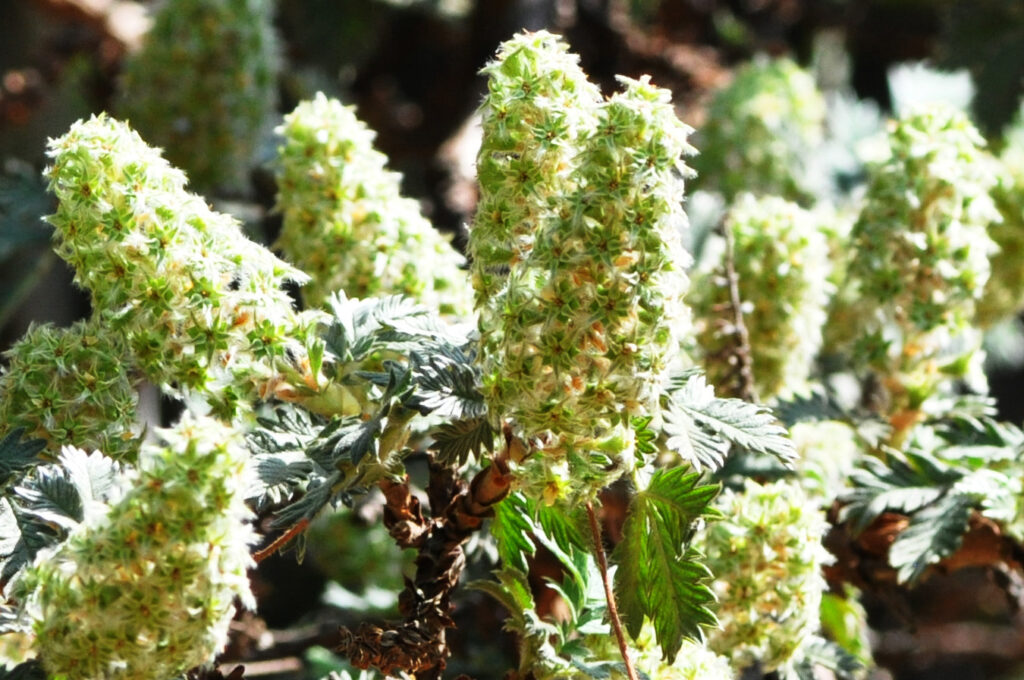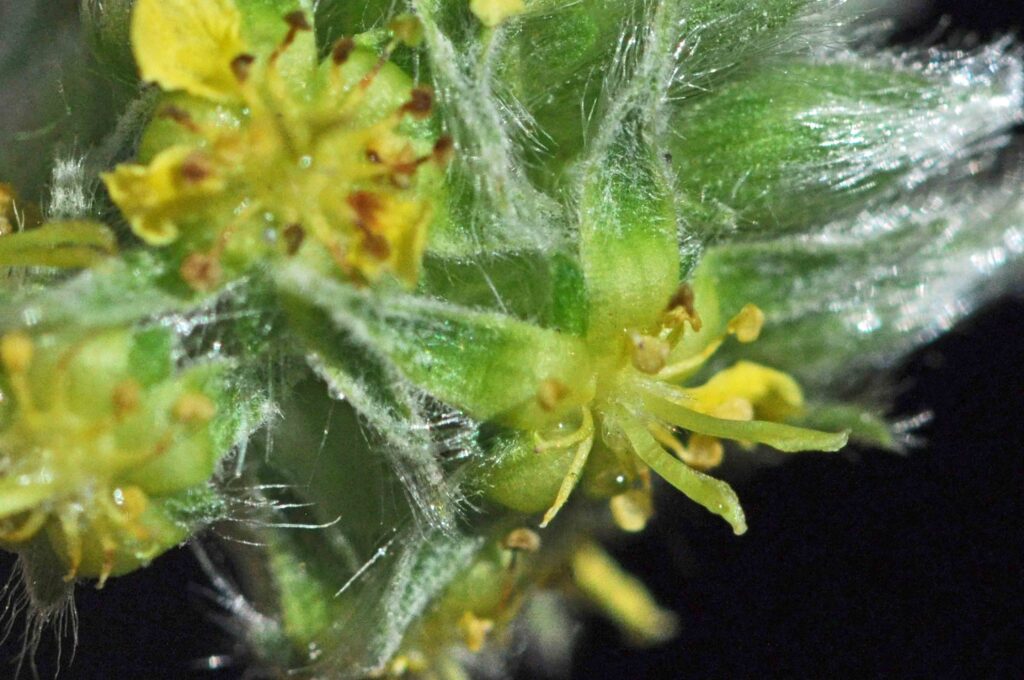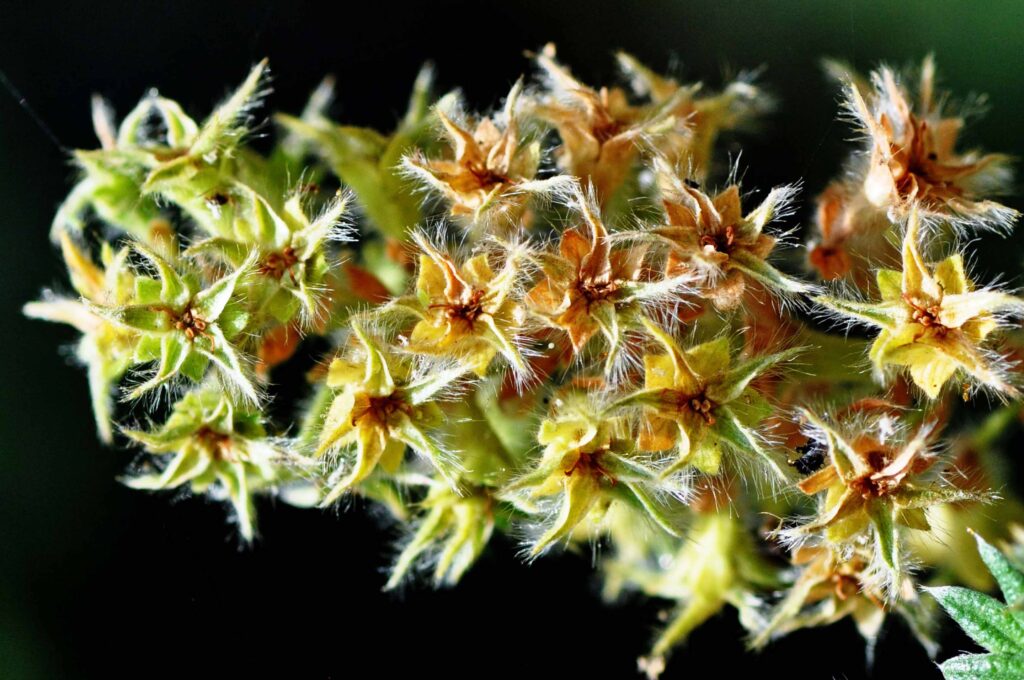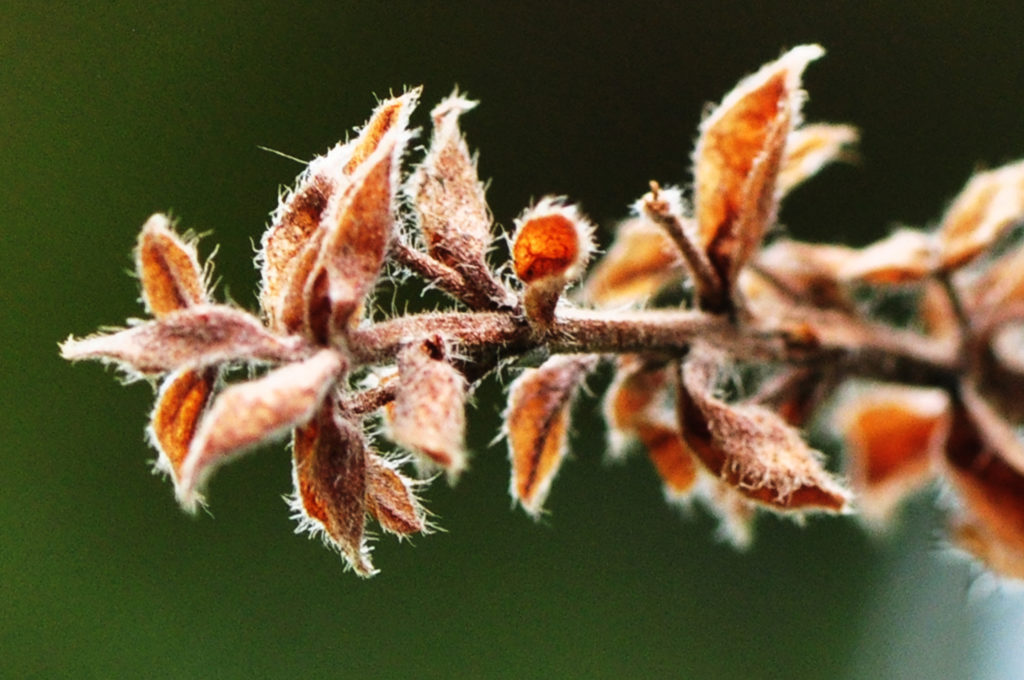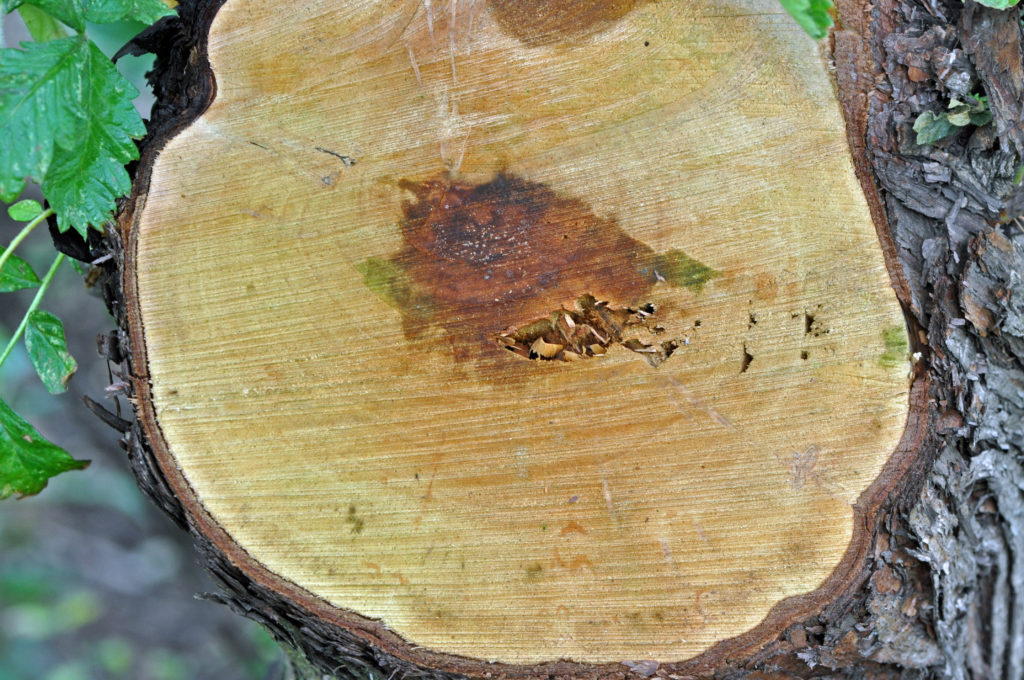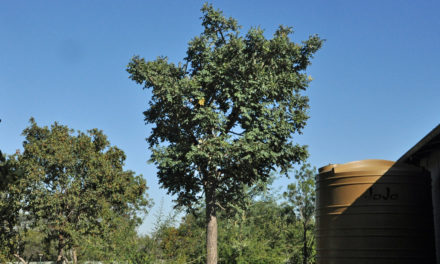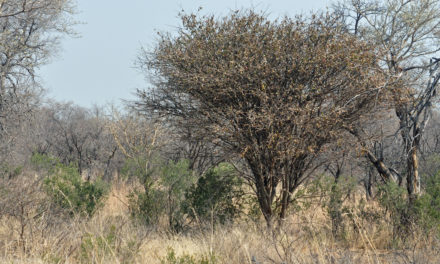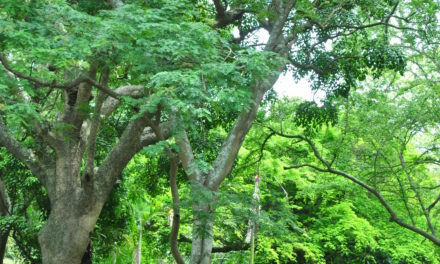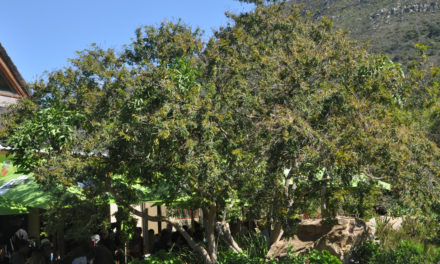General Info – summary
This small evergreen multi-stemmed shrub or small Tree has rough bark with persistent stipules. Leaves are imparipinnate, aromatic and shiny. The 2-4 pairs of leaflets have deeply serrated margins. Yellowish, bisexual, regular and star-like Flowers are in terminal racemes. Petals fall early & sepals are persistent. 10-12 didymous stamens are present. The ovary has 2-4 separate carpels. Fruit are nuts with tiny seeds.
Description
Leucosidea sericea
SA Tree No. 145.
Common names: (Afr) Broshout, Cheche, Dwadwa, Geelhout Oubaas, Oubos, Oudehout, Ouhout, Varingboom. (Eng) Old wood, Troutwood. (isiXhosa) Imtshitshi, Intshitshi, Isidwadwa, Isi-dwadwa, Isidwadwa, Isidwadwa, Umtyityi. (isiZulu) Umchichi, Umtshitshi, Umtyityi. (Northern Sotho) Mosino. (Setswana) Mosino, Tjhetjhe. (siSwati) Umchitsi. (Tshivenda) Munyongatshifumbu. Ouhout (refers to the “old-looking” trunk).
Family: Rosaceae (includes the rose, apples, pears, peaches, apricots, and strawberries). There are 90+ genera and nearly 5 000 species. Family members are usually perennial. Local genera on this website that contain trees include Leucosidea and Prunus). The usually spirally arranged Leaves can be simple or pinnately compound. Spines may be present on the midrib and rachis of compound leaves. Leaf/leaflet margins are usually serrate and stipules are present. Flowers are impressive, actinomorphic, bisexual and bracteate. Sepals and Petals both have 5 lobes and, together with the numerous Stamens, are fused at their bases. Stamens, petals and sepals are in a hypanthium (the cup-like receptacle derived usually from the fusion of floral envelopes and androecium, and on which are seemly borne calyx, corolla and stamens). The Fruits are various. Some Seeds may release cyanide if digested.
Name derivation: Leucosidea – shiny white – appearance of leaves in the sun. sericea – silky (hairs on leaves and buds). sericea – with long silky hairs. This is the only species in the genus Leucosidea.
Conservation: National Status: L C (Least Concern). Assessment: 2005 (W. Foden and L. Potter).
Tree
This plant is a multi-stemmed shrub or a small Tree (photo 495) – often with a twisted Trunk. It is usually much shorter than the maximum height of 15m and may reach 5m wide. The Bark is extremely rough and dark grey with the smooth red-brown underbark showing below (photo 504). The bark flakes off in recognisable longitudinal strips (hence the name: old wood). The young reddish branches have abundant soft unmated hairs. Conspicuous persistent Stipules (basal appendages of the petiole) are silky brown and up to 10 x 3,5mm. They are longer than the petiole and remain on the trees possibly for years after the leaves have fallen (photo 114).
- 495M. 2014/01/21. Walter Sisulu NBG. Photo: David Becking.
- 251. 2015/09/15. Walter Sisulu NBG. Photo: David Becking.
- 504. 2014/01/21. Walter Sisulu NBG. Photo: David Becking.
- 114. 2014/02/12. Walter Sisulu NBG. Photo: David Becking.
Leaves
On this evergreen tree, the densely packed Leaves are strongly aromatic when crushed. The arrangement of the slightly drooping leaves is either alternate or clustered. These compound leaves are imparipinnate (pinnately compound leaf ending in a single Leaflet – photo 167). Young leaves are a bright green colour (photo 511). Fine long silky unmated hairs cover the Rachis (main axis bearing leaflets in this case – photo 856). Leaves are up to 11cm long with 2-4 pairs of sessile leaflets plus the terminal one. Often even smaller leaflet pairs occur between the large leaflets (photo 856). The leaflet Margins are deeply serrated (photo 511) and leaflets are up to 3,5 x 1,8cm and obovate (the reverse of ovate, the terminal half broader than the basal). The end pair is usually larger than the lower leaflets (photo 856). The upper surface is dark green to grey-green with sunken veins (photo 167). The veins protrude on the Lower surface (photo 856) which is greyish green and has shiny silky hairs. These are clearly visible when the wind is blowing, and the sun is shining. The leaflet Apex is generally rounded and the Base tapers and may end in a short point. The hairy Petiole (leaf stalk) is up 1cm long.
- 167. 2014/01/15. Walter Sisulu NBG. Photo: David Becking.
- 511m. 2014/01/21. Walter Sisulu NBG. Photo: David Becking.
- 856. 2016/09/06. Walter Sisulu NBG. Photo: David Becking.
Flowers
The small star-like bisexual, yellowish green or yellow Flowers (photo 87) are actinomorphic (Regular, symmetrical. Flowers are vertically divisible into similar halves by more than 1 plane passing through the axis). In spring and early summer, the flowers develop at the ends of young shoots (photo 87) in sprays or Racemes (a simple elongated inflorescence with stalked flowers that open in succession towards the apex – photo 467). Each raceme develops on a single short peduncle (stalk of flower cluster). The Disc (a more or less fleshy or elevated development of the receptacle) initially surrounds and partly envelopes the calyx (photo 1020). The silky Calyx tube is obconic (resembles an inverted cone) and villous (provided with long and soft, not matted, hairs – photos 457 & 1020). The 10-12 hairy persistent Sepals occur in 2 whorls (photo 923 – under Fruit). The outer whorl is ovate, and the longer inner wall is linear-lanceolate. Those in the inner whorl are linear-lanceolate and the outer sepals are ovate. The Corolla is made up of 5 or 6 obovate yellow or yellowish green Petals (photo 467). The petals fall early – soon after pollination. Inserted on the disc (that almost encloses the mouth of the calyx tube) are 10-12 Stamens (photos 719 & 467). Here the Anthers (photo 457) are didymous (arranged or occurring in pairs). Flowers are Perigynous (The petals, sepals and stamens are on the rim of the cup-like receptacle). The semi-inferior Ovary has 2-4 separate, free and hairy carpels (female reproductive structure that encloses the ovule). Here each carpel has 1 ovule. Each Style is terete (circular in cross-section) and exserted (stick out – photo 457). Lateral stigmas are channelled and hooked (photo 457). (Jul-Dec).
- 467. 2019/09/03. Linden. Photo: David Becking.
- 1020. 2014/08/19. Walter Sisulu NBG. Photo: David Becking.
- 719. 2018/08/22. Walter Sisulu NBG. Photo: David Becking.
- 87. 2014/09/23. Walter Sisulu NBG. Photo: David Becking.
- 457. 2019/09/03. Linden. Photo: David Becking.
Fruit
The Fruit is a small membranous Achene/nut (a small dry indehiscent one seeded fruit with a tight, thin pericarp – the wall of the ripened ovary) enclosed in the base of old flower receptacles (photo 923). These develop in the old fruit. The black Seeds are very small. The remains of the fruit stay on the tree for some time (photo 508). Aug-Dec.
- 923. 2014/10/14. Walter Sisulu NBG. Photo: David Becking.
- 508. 2014/01/21. Walter Sisulu NBG. Photo: David Becking.
Distribution & Ecology
This Tree in endemic (restricted to a particular geographic location) in Southern Africa. It is a pioneer plant and a survivor especially at high altitudes (intro photo: near Golden Gate) and high rainfall areas e.g., Wakkerstroom on the boarder of Mpumalanga and KwaZulu-Natal. The tree grows in grassland and scrub forest. It is often confined to stream banks and kloofs (steep-sided, wooded ravines or valleys). Young parts are browsed. Being severe frost resistant, it usually grows above 1 100m to at least 2 100m (Intro Photo). Here this pioneer plant is often the only tree at high altitude in a bleak landscape. In Lesotho it is the most common indigenous tree. These trees occur in the Eastern Cape, Free State, North West, Mpumalanga, Limpopo, KwaZulu-Natal, and Gauteng – an impressive walk-through a forest of these trees can be undertaken at Walter Sisulu Botanical Gardens. Beyond South Africa, the trees occur in Lesotho, Eswatini (Swaziland), Zimbabwe, and western Mozambique.
Ethnobotany
The yellowish brown Wood (Geelhout: Afrikaans for yellow wood) is soft with a brown heartwood (photo 498). The density of wood is approximately 609kg per cubic metre. Anything less than 1 000kg per cubic metre will float in water. The wood is used for long lasting fence poles and as a fuel – especially for starting fires. It burns in a smouldering manner producing much smoke. In the higher parts of Lesotho, these trees are the only source of fuel. The presence of this tree apparently means that the nearby streams are suitable for trout (Troutwood is a common name). Stock browse the Flowers, Shoots and Leaves and leaves are a valuable spring feed. These plants can become an invasive problem especially in poorly maintained ground. This fast-growing tree grows easily from seed in wet areas. It is used for bonsai. The Roots are not aggressive. No part of the plant is poisonous and usually the leaves are used in local medicine. Scientific research of Leaf extracts exhibited a broad-spectrum of antibacterial activity, supporting its use in local medicine.
- 498. 2014/01/14. Walter Sisulu NBG. Photo: David Becking.
References
Boon, R. 2010. Pooley’s Trees of eastern South Africa. Flora and Fauna Publications Trust, Durban.
Burrows, J.E., Burrows, S.M., Lotter, M.C. & Schmidt, E. 2018. Trees and Shrubs Mozambique. Publishing Print Matters (Pty) Ltd. Noordhoek, Cape Town.
Coates Palgrave, M. 2002. Keith Coates Palgrave Trees of Southern Africa, edn 3. Struik, Cape Town.
Foden, W. & Potter, L. 2005. Leucosidea sericea Eckl. & Zeyh. National Assessment: Red List of South African Plants version 2020.1. Accessed on 2023/08/30.
Lawrence, G. H. M, 1951. Taxonomy of Vascular Plants. The Macmillan Company, New York. Tenth Printing 1965.
Palmer, E. & Pitman, N. 1972. Trees of southern Africa. Balkema, Amsterdam, Cape Town.
Schmidt, S. Lotter, M. & McCleland, W. 2002. Trees and Shrubs of Mpumalanga and the Kruger National Park. Jacana, Johannesburg.
van Wyk, B. & van Wyk, P. 1997 Field guide to Trees of Southern Africa. Struik, Cape Town.
http://www.plantzafrica.com/plantklm/leucosidseri.htm
https://en.wikipedia.org/wiki/Leucosidea
http://posa.sanbi.org/flora/browse.php?src=SP

